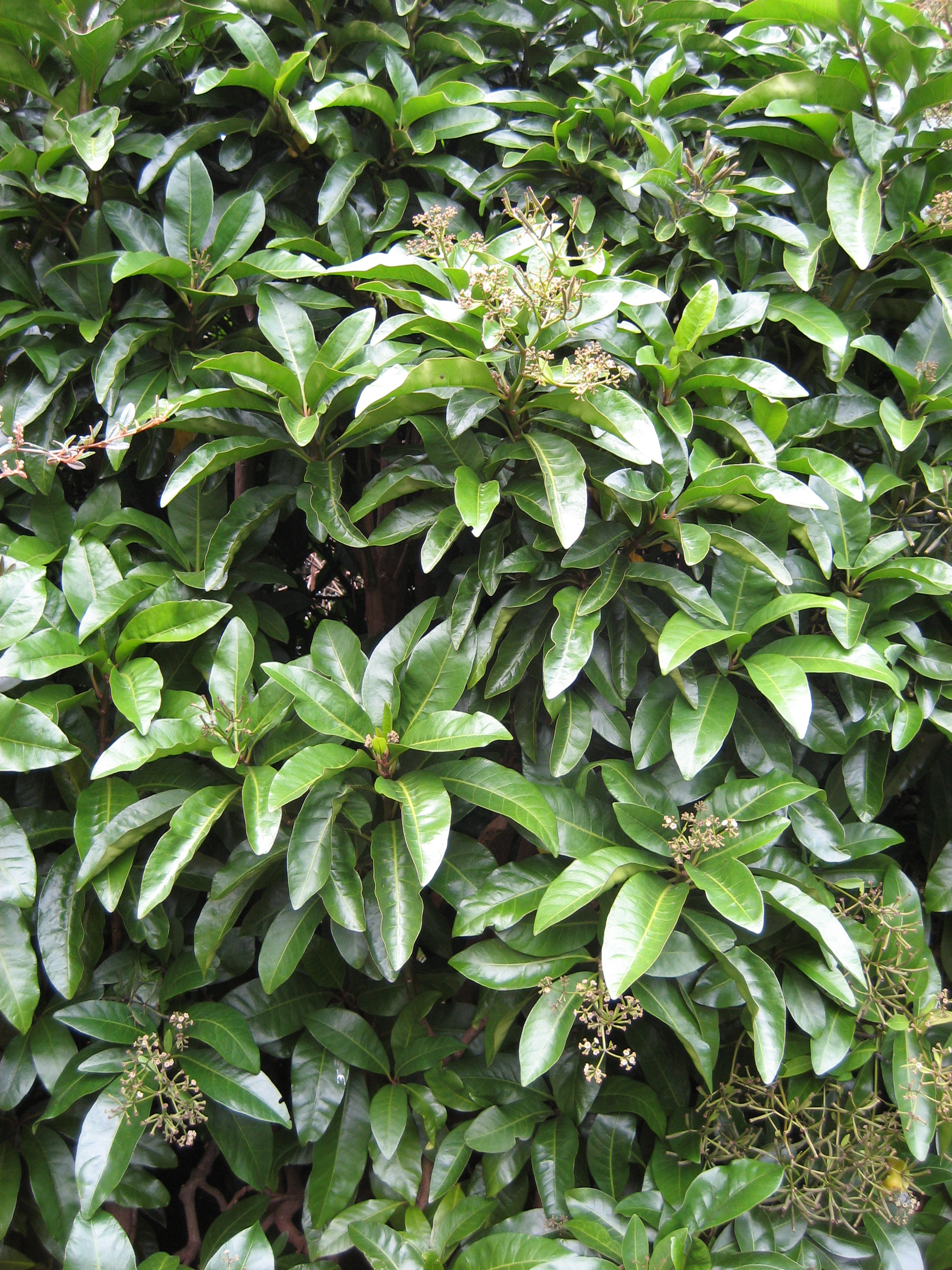- Pisonia brunoniana
Taxobox
name = "Pisonia brunoniana"

regnum =Plant ae
divisio = Magnoliophyta
classis =Magnoliopsida
ordo =Caryophyllales
familia =Nyctaginaceae
genus = "Pisonia "
species = "P. brunoniana"
binomial = "Pisonia brunoniana"
binomial_authority =Endl.
synonyms = "Pisonia sinclairii"Hook.f.
"Heimerliodendron brunonianum" (Endl.) Skottsb."Pisonia brunoniana" is a small tree native to
New Zealand ,Norfolk Island ,Lord Howe Island andHawaii . The common names in New Zealand are "Parapara" or "Birdcatcher tree".Habit
"Pisonia brunoniana" is a spreading tree to 6 m or more tall. The wood is soft and the branches are brittle. The large leaves are opposite or ternate, glabrous, and glossy, entire, and obtuse to rounded at apex. The inflorescence is paniculate, many-flowered, and the flowers are unisexual. The very sticky fruits, in which small birds are often trapped, are narrowly ellipsoidal, and 2–3 cm long, having 5 ribs.
Distribution in New Zealand
In New Zealand, "Pisonia brunoniana" grows in coastal forest on
Raoul Island in the Kermadec group, on theThree Kings Islands , and in theNorth Island in scattered locations fromWhangape Harbour toMangawhai . Historically, it grew nearAuckland , on theCoromandel Peninsula and atEast Cape . It is now mainly found on offshore islands, especially rodent-free islands, where it often forms an important understorey component of mixed-broadleaf forest.The plant is almost extinct in the North Island, partly because the large leaves of "P. brunoniana" are eagerly eaten by browsing animals such as possums,
goat s and feralcattle . However the main threat to accessible populations is the cutting down of trees by people trying to prevent small songbirds from becoming trapped by the sticky seeds. [Research in theSeychelles into seabird deaths caused by a related species, "Pisonia grandis ", indicates that the sticky fruits were evolved to increase the likelihood that they will be transferred on the plumage of a seabird to a distant island, thus acting to promote the long-distance dispersal of the species ("Nature Seychelles", [http://www.natureseychelles.org/index.php?option=content&task=view&id=73 Seabirds killed by trees: accident or design?] . Accessed 11 May 2007).]The plant is reasonably common in cultivation as a decorative tree in New Zealand, especially in the northern North Island. Two variegated cultivars are sold as "P. brunoniana" in New Zealand nurseries, although one of these, which has leaves extensively marbled with white, may in fact be "P. umbellifera", a similar species which occurs throughout the tropical
Indo-Pacific .In Hawaiokinai
In Hawaiokinai, where it is known as "pāpala kēpau", "P. brunoniana" is most common in dry to mesic habitats. Although abundant in certain locations, such as Kīpuka Puaulu, it has a relatively restricted distribution compared to the related species "P. sandwicensis" and "P. umbellifera". The sticky fruits were employed by the Hawaiian "kia manu" (bird catchers) to trap birds in order to collect feathers for capes and other objects.
Notes
References
*Metcalf, Laurie, 2002. "A Photographic Guide to Trees of New Zealand". Auckland: New Holland.
*Salmon, J.T., 1986. "The Native Trees of New Zealand". Wellington: Heinneman Reed.
* "Flora of Australia Online [http://www.anbg.gov.au/abrs/abif/flora/stddisplay.xsql?pnid=5244 "Pisonia brunoniana"] . Accessed 3 May 2007.
* "Hawaiian Ethnobotany Online Database", Bishop Museum. URL: [http://www2.bishopmuseum.org/ethnobotanydb/resultsdetailed.asp?search=papala_kepau "Papala kepau"] . Accessed 3 May 2007.
* "New Zealand Plant Conservation Network", URL: [http://www.nzpcn.org.nz/vascular_plants/detail.asp?PlantID=306 "Pisonia brunoniana"] . Accessed 3 May 2007.
* "Plants of Hawaii", URL: [http://www.hear.org/starr/hiplants/images/thumbnails/html/pisonia_brunoniana.htm "Papala kepau"] . Accessed 3 May 2007.
Wikimedia Foundation. 2010.
